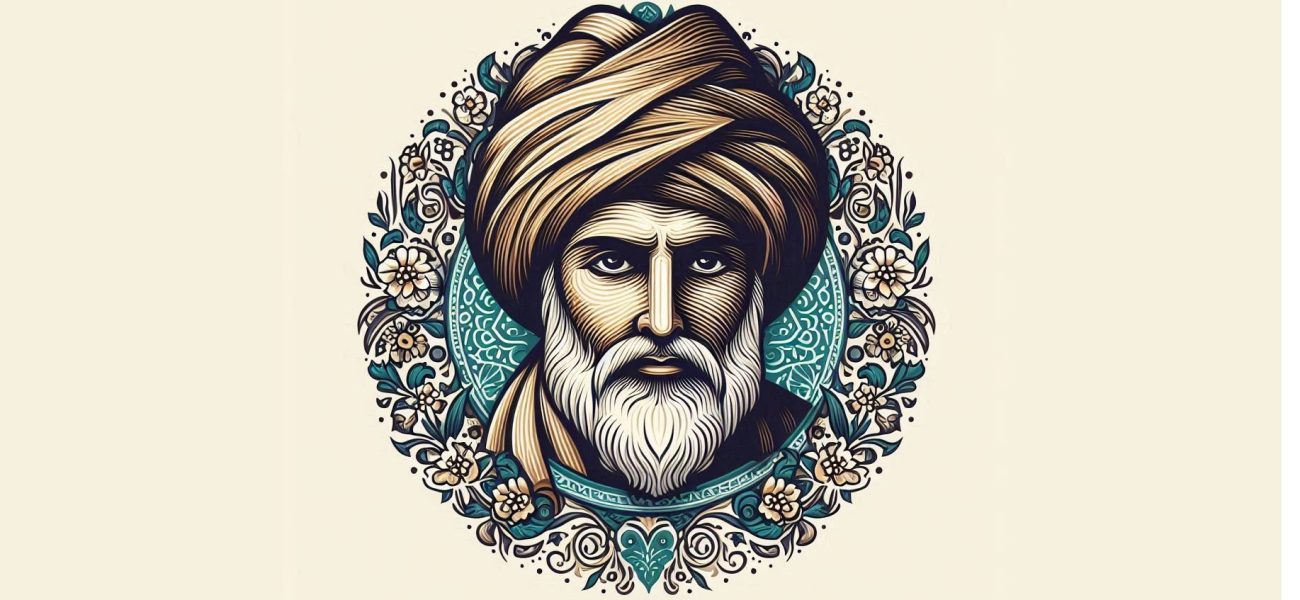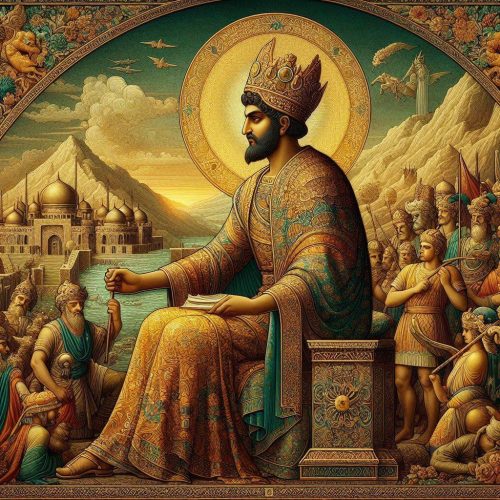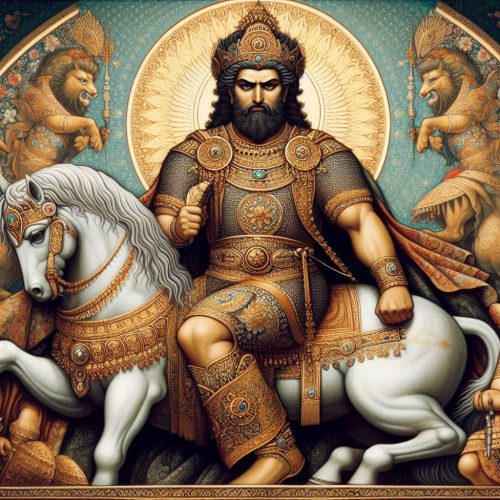In the tapestry of Persian literature, there are threads of gold that shine with a brilliance undimmed by the passage of centuries. Among these lustrous strands, the name of Abu Mansur Muhammad ibn Ahmad Daqiqi Tusi stands out with particular radiance. Known simply as Daqiqi to those who cherish the legacy of Iranian poetic tradition, this 10th-century bard sang of fire and faith, of kings and conquests, in verses that still echo through the corridors of time.
As we embark on this exploration of Daqiqi’s life and works, let us first pause to consider the meaning hidden within his name. ‘Daqiqi’ – derived from the Arabic ‘daqīq’, meaning ‘minute’ or ‘subtle’ – is a name that belies the grandeur of his poetic vision. For in his verses, there is nothing minute; rather, we find sweeping vistas of history and mythology, rendered with a subtlety of language that elevates the craft of poetry to new heights.
The Man Behind the Verses: Daqiqi’s Name and Background
Abu Mansur Muhammad ibn Ahmad – such was the full name bestowed upon our poet at birth. Born in Tus, a city in the province of Khorasan that would later give rise to luminaries such as Ferdowsi and Al-Ghazali, Daqiqi emerged into a world poised between two great epochs of Persian history. The Samanid dynasty, under whose reign he would flourish, represented a renaissance of Iranian culture after centuries of Arab dominance. It was a time of rediscovery, of reaching back into the pre-Islamic past to reclaim a heritage long overshadowed.
In this crucible of cultural revival, young Muhammad, who would come to be known as Daqiqi, was forged. The epithet ‘Tusi’ speaks to his origins in Tus, a city steeped in Zoroastrian lore and Persian tradition. It was here, amidst the whispers of ancient fire temples and the echoes of Avestan chants, that Daqiqi’s poetic sensibilities were first kindled.
But what of the man himself? History, ever capricious in its record-keeping, has left us with tantalizingly few details of Daqiqi’s personal life. We are left to piece together his story from fragments of verse and fleeting mentions in the works of later scholars. Yet, in this very absence, we find a canvas upon which to project the ideals and aspirations of an entire era.
The Flame of Faith: Daqiqi’s Religious Background
To speak of Daqiqi’s religious background is to delve into one of the most fascinating aspects of his legacy. In an age when Islam had long since become the dominant faith of Persia, Daqiqi stood as a beacon of an older tradition. His verses pulse with the rhythms of Zoroastrian thought, celebrating the eternal struggle between light and darkness, good and evil.
It would be an oversimplification, however, to label Daqiqi merely as a Zoroastrian poet. His relationship with faith was as complex and nuanced as the verses he crafted. In his poetry, we find a synthesis of spiritual traditions – the fire worship of his ancestors intertwined with the Islamic sensibilities of his contemporaries. This syncretic approach to faith mirrored the cultural milieu of the Samanid court, where Persian traditions were being rediscovered and reinterpreted through an Islamic lens.
Daqiqi’s religious background was not merely a personal matter; it was the wellspring from which flowed his most profound poetic inspirations. His familiarity with Zoroastrian texts and traditions allowed him to tap into a rich vein of mythological and historical material that had been largely neglected by poets of the Islamic era. In doing so, he played a crucial role in preserving and revitalizing aspects of pre-Islamic Persian culture that might otherwise have been lost to time.
Consider these lines, which speak to the poet’s spiritual leanings:
In this world, I have chosen four things Above all else that noble and base might bring: Ruby lips, the lament of the lute, Blood-red wine, and the Zoroastrian creed.
Here, we see Daqiqi not as a dogmatic adherent to any single faith, but as a seeker of truth and beauty wherever they may be found. The inclusion of the ‘Zoroastrian creed’ alongside sensual pleasures speaks to a worldview that saw no contradiction between spiritual devotion and earthly joy. It is a testament to the complexity of Daqiqi’s religious background – a complexity that would infuse his work with a depth and resonance unmatched by many of his contemporaries.
A Life in Verse: Daqiqi’s Biography
The life of Daqiqi, like a poem half-remembered, comes to us in fragments and whispers. Born sometime in the middle of the 10th century CE, he lived and wrote during the golden age of the Samanid dynasty. This was an era of unprecedented cultural flowering in Persia, a time when the courts of Bukhara and Samarkand glittered with the brilliance of poets, philosophers, and scientists.
Young Daqiqi, blessed with a keen intellect and a gift for language, would have received the finest education available in Tus. We can imagine him pouring over ancient manuscripts, his mind alight with tales of legendary kings and heroic deeds. Perhaps it was during these formative years that the seed of his magnum opus – the versification of the Shahnameh – was first planted.
As his reputation grew, Daqiqi was drawn to the Samanid court in Bukhara. Here, under the patronage of enlightened rulers who cherished Persian culture, our poet found a stage worthy of his talents. The court was a crucible of creativity, where poets engaged in verbal duels of wit and skill. Daqiqi, with his masterful command of language and deep well of historical knowledge, would have shone brightly in this illustrious company.
It was at the Samanid court that Daqiqi began his most ambitious project – the transformation of Ferdowsi’s Shahnameh from prose to verse. This monumental task, which would ultimately be completed by Ferdowsi himself, speaks to Daqiqi’s status as one of the preeminent poets of his age. To be entrusted with such a culturally significant work was both an honor and a tremendous responsibility.
Yet the life of a court poet was not without its perils. The same wit that won Daqiqi acclaim could also make enemies. We know that his life was cut tragically short – some sources suggest he was murdered by a Turkish slave, though the details remain shrouded in mystery. What we do know is that he died young, leaving behind a body of work that, while limited in quantity, is limitless in its impact on Persian literature.
In the end, perhaps it is fitting that we know so little of Daqiqi’s personal life. For it is through his verses that he truly lives – each line a heartbeat, each poem a breath drawn across the centuries. In exploring his biography, we are reminded that the truest measure of a poet’s life is not in the mundane details of daily existence, but in the enduring power of their words.
The Legacy in Letters: Daqiqi’s Works
To speak of Daqiqi’s works is to speak of a treasure trove only partially unearthed. Time and circumstance have conspired to rob us of much of his poetic output, leaving us to wonder at the full extent of his genius. Yet, what remains is sufficient to secure his place in the pantheon of Persian literature.
Daqiqi’s most significant contribution to Persian literature was undoubtedly his work on the Shahnameh. Though he completed only a small portion of this epic before his untimely death – some thousand verses chronicling the reign of Gushtasp and the coming of Zoroaster – his influence on the work was profound. Ferdowsi, in completing the Shahnameh, paid homage to Daqiqi by incorporating his verses wholesale into the epic, a testament to their quality and importance.
Consider these lines from Daqiqi’s portion of the Shahnameh, describing the advent of Zoroaster:
When Zartosht appeared before the Shah, He bore a cypress tree from Paradise. Upon its bark was written: ‘Gushtasp Hath accepted the Good Religion.’
Here, we see Daqiqi’s skill in weaving together historical narrative and religious symbolism. The cypress tree, sacred in Zoroastrian tradition, becomes a vehicle for divine revelation. In just a few lines, Daqiqi captures the momentous nature of Zoroaster’s appearance and its impact on Persian kingship.
Beyond his work on the Shahnameh, Daqiqi was renowned for his ghazals and qasidas. These shorter forms allowed him to display his mastery of language and imagery in concentrated bursts of poetic brilliance. His ghazals, in particular, are noted for their passionate intensity and innovative use of imagery.
One of his most famous ghazals begins:
The idol with a face like tulips came, A cup of wine in hand, into the garden. She sat beside me, kissed me, and said: ‘O soul of mine, for whom do you lament?’
In these lines, we see Daqiqi’s skill in blending sensual imagery with deeper philosophical questions. The beautiful beloved becomes a vehicle for exploring themes of desire, spirituality, and the nature of existence itself.
Daqiqi’s qasidas, while fewer in number, showcase his ability to handle more complex themes and structures. These longer poems often combined praise for his patrons with reflections on life, death, and the human condition. In one particularly striking qasida, he muses:
The world is but a caravanserai, And we the passing caravan. Why build palaces on shifting sand? Why seek permanence in this transient land?
Here, Daqiqi touches on themes that would become central to later Persian mystical poetry. The image of the world as a caravanserai – a temporary resting place for travelers – speaks to the ephemeral nature of earthly existence and the folly of attachment to worldly things.
Perhaps the most tantalizing aspect of Daqiqi’s works is what has been lost to time. References in later sources suggest that he composed a substantial body of poetry that has not survived. We can only imagine the treasures that may have been lost – the ghazals that might have set hearts aflame, the qasidas that could have moved kings to tears.
Yet, even in this loss, there is a poetic symmetry. For Daqiqi, who sought to preserve the ancient stories of Persia, has himself become a figure of legend. His works, fragmented and incomplete as they may be, stand as a testament to the power of poetry to transcend time and death.
The Poet’s Craft: Daqiqi’s Style and Themes
To truly appreciate Daqiqi’s contributions to Persian literature, we must delve into the intricacies of his poetic style and the themes that dominate his work. Daqiqi was a master craftsman of verse, wielding language with a precision and elegance that set him apart from his contemporaries.
One of the hallmarks of Daqiqi’s style is his innovative use of imagery. He had a particular talent for creating vivid, sensory-rich metaphors that brought his verses to life. Consider this line from one of his ghazals:
Her face, a garden in full bloom; her hair, The night that falls upon that paradise.
Here, in just a few words, Daqiqi paints a picture of beauty so vivid that it almost leaps off the page. The comparison of the beloved’s face to a garden in bloom evokes a sense of freshness and vitality, while the image of her hair as the night falling on this garden adds a touch of mystery and allure.
Another key aspect of Daqiqi’s style was his mastery of prosody. He was adept at manipulating the complex meters of Persian poetry, creating rhythms that could be by turns flowing and lyrical or sharp and incisive. His command of rhyme and radif (the repeating word or phrase at the end of each couplet in a ghazal) allowed him to create poems that were not only pleasing to the ear but also rich in meaning.
In terms of themes, Daqiqi’s work is characterized by a unique blend of the sensual and the spiritual, the historical and the personal. His poetry often explores the tension between earthly desires and higher aspirations, a theme that would become central to later Persian mystical poetry.
One recurring theme in Daqiqi’s work is the transience of life and the inevitability of death. This preoccupation with mortality gives many of his poems a bittersweet quality, as in these lines:
The rose that blooms today will wither tomorrow, The cypress that stands tall will one day fall. In this garden of life, O heart, be wise: Seize the moment, for it soon will pass.
Here, Daqiqi uses the familiar imagery of the garden – a staple of Persian poetry – to reflect on the ephemeral nature of existence. The contrast between the short-lived rose and the seemingly eternal cypress serves as a poignant reminder of the varied but ultimately finite nature of all things.
Another significant theme in Daqiqi’s work is his exploration of pre-Islamic Persian history and mythology. This is most evident in his work on the Shahnameh, but it also appears in his other poems. Daqiqi saw himself as a preserver of Persian cultural heritage, using his verses to keep alive the stories and values of ancient Iran.
Consider these lines, which evoke the glory of ancient Persian kings:
From Jamshid’s throne to Khosrow’s crown, From Rustam’s mace to Bahram’s bow, The legacy of Persia lives In every verse that poets know.
Here, Daqiqi deftly weaves together references to legendary figures from Persian history and mythology, creating a sense of continuity between the ancient past and his present day.
Finally, we cannot discuss Daqiqi’s themes without mentioning his treatment of love. Like many Persian poets, Daqiqi wrote extensively about love in all its forms – from the sensual passion of human relationships to the divine love of the mystic for God. His love poetry is characterized by its intensity and its ability to use the language of earthly love to explore deeper spiritual truths.
In one particularly beautiful ghazal, he writes:
Your love, a flame; my heart, a moth – How can I not be drawn to burn? In this consuming fire I learn The secret hidden since my birth.
Here, Daqiqi employs the classic image of the moth drawn to the flame – a common metaphor in Persian poetry for the soul’s attraction to the divine. Yet he imbues it with a personal urgency that speaks to the transformative power of love, both human and divine.
The Poet’s Legacy: Daqiqi’s Influence on Persian Literature
As we draw our exploration of Daqiqi’s life and works to a close, it is fitting that we consider the lasting impact of this remarkable poet on the landscape of Persian literature. Though his life was cut tragically short, the ripples of Daqiqi’s influence continue to be felt more than a millennium after his death.
Perhaps Daqiqi’s most significant contribution to Persian literature was his role in reviving interest in pre-Islamic Persian history and mythology. By beginning the versification of the Shahnameh, he set in motion a project that would culminate in one of the greatest works of world literature. Ferdowsi, in completing the Shahnameh, built upon the foundation laid by Daqiqi, and in doing so, ensured that the stories and values of ancient Persia would be preserved for future generations.
But Daqiqi’s influence extends far beyond his work on the Shahnameh. His innovative use of imagery and his skillful blending of sensual and spiritual themes set a new standard for Persian poetry. Later poets, including giants of the tradition such as Hafez and Rumi, would build upon the techniques pioneered by Daqiqi, creating works of unparalleled beauty and depth.
Daqiqi’s exploration of themes such as the transience of life and the power of love also had a profound impact on the development of Persian mystical poetry. His ability to use the language of earthly passion to express spiritual truths paved the way for the great Sufi poets who would follow him.
Moreover, Daqiqi’s commitment to preserving and celebrating Persian cultural heritage in the face of Arab cultural domination set an important precedent. He showed that it was possible to embrace the new faith of Islam while still honoring the rich traditions of pre-Islamic Persia. This synthesis of Persian and Islamic elements would become a defining feature of Iranian culture in the centuries that followed.




